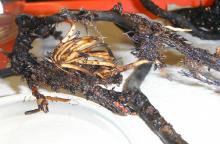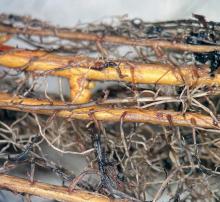By L. Sims
See:
Rhododendron - Phytophthora Root Rot
Cause There have been 12 Phytophthora spp. found across western Oregon on Alnus rubra (red alder) and Alnus rhombifolia (white alder). Phytophthora gonapodyides and "P. taxon Pgchlamydo" were found most often from fine and necrotic woody root lesions on red alder but P. alni, P. cambivora, P. europaea, P. lacustris P. pseudosyringae, and P. siskiyouensis were also isolated.
Phytophthora alni was found in a few samples from south-central and interior Alaska in 2008 and also infrequently in western Oregon. The organism does not seem to be spreading like a similarly named organism in Europe. The pathogen in Europe caused a new collar-rot disease of European alders. This Phytophthora was isolated and shown to comprise a swarm of hybrids between two P. cambivora and a Phytophthora close to P. fragariae. The organism from Europe is on Oregon's quarantine list.
Symptoms Dark-brown-to-black lesions occur on fine and woody roots.
Cultural control
- Plant in areas with good drainage.
- Do not allow lawn sprinklers to wet lower trunks of trees.
- Correct drainage problems around trees.
Chemical control There are no fungicides specifically registered for this disease on this crop. However, several fungicides such as Aliette, Fosphite, Mefenoxam or Subdue may be effective if not phytotoxic to the plants. Fungicides work best when used as a protectant in combination with cultural controls.
Reference Sims, L.L., Sutton, W., Reeser, P., and Hansen, E.M. 2015. The Phytophthora species assemblage and diversity in riparian alder ecosystems of western Oregon, USA. Mycologia, 107:889-902.



